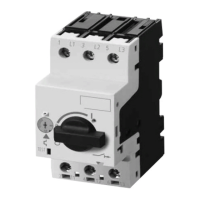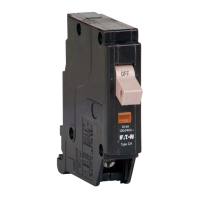I.B. 32-255-1G
Page 17
Effective 12/02
4-8 ELECTRICAL OPERATION CHECK
After having completed all previous checks and tests,
the circuit breaker is ready to be operated electrically. It
is preferred that this check be made with the circuit
breaker in a TEST position or by using a test cable, if
the circuit breaker is outside the cell structure.
BEFORE INSERTING THE CIRCUIT BREAKER EXAM-
INE THE INSIDE OF THE CELL STRUCTURE FOR
EXCESSIVE DIRT OR ANYTHING THAT MIGHT INTER-
FERE WITH THE CIRCUIT BREAKER MOVEMENT.
EXTREME CAUTION MUST BE EXERCISED TO
INSURE THAT PRIMARY CIRCUITS ARE NOT ENER-
GIZED WHILE CHECKS ARE PERFORMED IN THE
CIRCUIT BREAKER COMPARTMENT. FAILURE TO
DO SO MAY RESULT IN PERSONAL INJURY OR
DEATH.
The circuit breaker is normally tested electrically in its
cell structure in the TEST position. To achieve the TEST
position, the circuit breaker must first be placed in the
cell structure and the secondary contacts engaged. To
complete this testing procedure, the operator should first
be familiar with inserting and removing the circuit break-
er into and from the cell structure.
4-8.1 CIRCUIT BREAKER INSERTION AND
REMOVAL
Make certain that the levering nut is all the way for-
ward in the TEST position before attempting to
insert a circuit breaker into its compartment (Figure
4-2).
If the circuit breaker is being inserted into an upper com-
partment or will be positioned in a lower compartment
without the use of a drawout ramp or dockable
dolly, the extension rails must first be put in position.
Carefully engage the left and right extension rails to the
fixed structure rails and ensure they are properly seated
in place (Figure 4-3). Once the extension rails are prop-
erly in place, the circuit breaker can be carefully loaded
on the extension rails using an overhead lifter and lifting
yoke. Remove the lifting yoke when the circuit breaker is
securely seated on the extension rails.
Push the circuit breaker into the compartment until the
TEST position is reached as confirmed by a metallic
sound of the breaker levering latch engaging the levering
nut (Figures 4-2 and 4-4). Once the circuit breaker is in
the TEST position, the extension rails can be removed.
To engage the circuit breaker secondary contacts, raise
the handle to the secondary disconnect cage and pull
the cage forward as far as possible (Figure 4-5). As
soon as control power is available, the motor will start
charging the closing springs.
DO NOT USE ANY TOOL OTHER THAN THE LEVER-
ING-IN CRANK PROVIDED TO LEVER THE CIRCUIT
BREAKER FROM TEST OR CONNECTED POSI-
TIONS. CORRECT OPERATION OF SOME OF THE
INTERLOCKS IS DEPENDENT ON USE OF THE
PROVIDED LEVERING CRANK. PERSONAL INJURY
OR EQUIPMENT DAMAGE COULD RESULT FROM
THE USE A TOOL OTHER THAN THE PROPER LEV-
ERING-IN CRANK.
The circuit breaker and integral levering mechanism
includes all necessary interlocks that when inter-
faced with a compatible structure will render the cir-
cuit breaker mechanism mechanically and electri-
cally trip-free during the levering process. For infor-
mation pertaining to individual interlocks, refer to
paragraph 4-9 in this section.
To move the circuit breaker to the CONNECTED posi-
tion, engage the levering-in crank with the structure
mounted levering shaft (Figure 4-6). Turn the levering-in
crank in a clockwise direction and the circuit breaker will
move slowly toward the rear of the structure. When the
circuit breaker reaches the CONNECTED position, it will
become impossible to continue turning the levering-in
crank. The CONNECTED position will also be indicated
by a red flag indicator just below the levering device. If a
spin-free levering-in crank is being used, it will spin free
once the CONNECTED position is reached. Secondary
contacts will automatically engage if not already
engaged manually in the TEST position.

